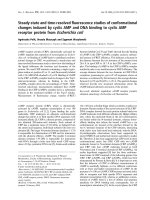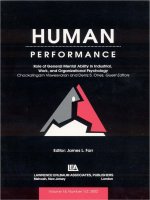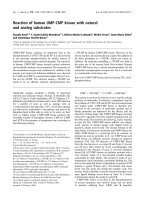Avalanche Dynamics Dynamics of Rapid Flows of Dense Granular Avalanches by SP Pudasaini and Kolumban Hutter_1 docx
Bạn đang xem bản rút gọn của tài liệu. Xem và tải ngay bản đầy đủ của tài liệu tại đây (272.89 KB, 9 trang )
In-House Laboratory Independent
Research Program
A
Finite Element Scheme
for Shock Capturing
by
R.
C.
Berger, Jr.
Hydraulics Laboratory
U.S. Army Corps of Engineers
Waterways Experiment Station
3909 Halls Ferry Road
Vicksburg, MS 391 80-61 99
Final report
Approved for public release; distribution is unlimited
Technical Report HL-93-12
August 1993
Prepared for
Assistant Secretary
of
the Army (R&D)
Washington, DC 2031
5
Waterways Experiment Station Cataloging-in-Publication Data
Berger, Rutherford
C.
A finite element scheme for shock capturing
/
by R.C. Berger, Jr.,
;
prepared
for Assistant Secretary of the Army
(R&D).
61 p.
:
ill.
;
28 cm.
-
(Technical report
;
HL-93-12)
Includes bibliographical references.
1. Hydraulic jump
-
Mathematical models. 2, Hydrodynamics. 3. Shock
(Mechanics)
-
Mathematical models.
4.
Finite element method.
I.
United
States. Assistant Secretary of
the Army (Research, Development and Acquisi-
tion)
11.
U.S. Army Engineer Waterways Experiment Station.
Ill.
In-house Labo-
ratory Independent Research Program (U.S. Army Engineer Waterways
Experiment Station) IV. Title. V. Series: Technical report (U.S. Army Engineer
Waterways Experiment Station)
;
HL-93-12.
TA7 W34 no.HL-93-12
Contents
Preface
iv
Background
1
Basic Equations 2
Shock equations
4
Shock relations in 2-D
9
2-Numerical Approach 13
Advective Dominated Flow
13
The Problem 13
Petrov-Galerkin formulation 14
Shock Capturing 20
Case 1: Analytic Shock Speed
24
Case 2: Dam Break
28
Case
3:
2-D Lateral Transition
40
Discussion
43
References
55
Preface
This report is the product of research conducted from January
1992
through
April
1993
in the Estuaries Division (ED), Hydraulics Laboratory (HL), U.S.
Army Engineer Waterways Experiment Station (WES), under the In-House
Laboratory Independent Research (ILIR) Program. The funding was providing
by ILIR work unit "Finite Element Scheme for Shock Capturing."
Dr.
R.
C.
Berger, Jr., ED, performed the work and prepared this report
under the general supervision of Messrs.
F.
A. Herrmann, Jr., Director, HL;
R. A. Sager, Assistant Director,
HL;
and W. H. McAnally, Chief, ED.
Mr. Richard Stockstill of the Hydraulic Structures Division, HL, performed
the test on supercritical contraction.
At the time of publication of this report, Director of WES was Dr. Robert
W.
Whalin. Commander was COL Bruce
K.
Howard, EN.
ntroduction
Background
Shocks in fluids result from fluid flow that is more rapid than the speed of
a compression wave. Thus there is no means for the flow to adjust gradually.
Pressure, velocity, and temperatures change abruptly, causing severe fatigue
and component destruction in military aircraft and engine turbines. This
problem is not limited
to
supersonic aircraft; many parts of subsonic craft are
supersonic. For example, the rotors of helicopters have supersonic regions as
do the blades of the turbine engines used on many crafts. The shock is formed
as the flow passes from supersonic
to
subsonic or, in the case of an oblique
shock, as the result of a geometric transition in supersonic flow. Wind tunnels
are limited in the Mach numbers they can achieve and testing is expensive;
thus design relies upon numerical modeling. In
Gdraulics the equivalent
shocks are referred to as hydraulic jumps, surges, and bores. Here, for
example, it is important to determine the ultimate height of water resulting
from a dam break or the insertion of a bridge in a fast-flowing river.
The compressible Euler equations describe these flow fields and are solved
numerically in discrete models. These partial differential equations implicitly
assume a certain degree of smoothness in the solution. Models, therefore,
have great difficulty handling shocks. One method to avoid solving
numerically across the shock is to track the shock and impose an internal
boundary there.
This method is called "shock-tracking." On the other hand
the sharp resolution of the shock can be forfeited and allow for
O(1)
error at
the transition. This is referred to as "shock-capturing," as originated by
von Neumann and Richtmyer
(1950),
and is now the most common technique
used in engineering practice.
Great care must be undertaken to make sure the errors are local to the
shock.
Otherwise the shock location and speed will be incorrect. It is
important that the discrete numerical operations preserve the Rankine-Hugoniot
condition (Anderson,
Tannehill, and Plekher
1984)
resulting
from
integration
by parts. While this should result in reasonable shock speed and location,
discrete models commonly suffer from numerical oscillations near the shock.
There are many proposed methods used to reduce these oscillations. The
Chapter
1
Introduction
basic theme is to cleverly apply artificial diffusion as a result of flow
parameters. Many of these methods do not preserve the original equations
within the shock due to this added diffusion. Hughes and Brooks (1982) have
approached this problem within the finite elements method
by
the development
of a single test function that reflects the speed of fluid transport (the SUPG
scheme,
Streamline llpwind Eetrov-Galerkin) to be applied to the entire partial
differential equation set. In this manner the model is consistent even at
discrete scales. Its application, thus far, has been only to the very simple case
of Burgers' equations.
In this report a two-dimensional
(2-D)
finite element model for the shallow-
water equations is produced using an extension of the SUPG concept, but rely-
ing upon the characteristics of the advection matrix (transport as well as the
free-surface wave speeds) to develop the test function to be applied to the
coupled set of equations. The shallow-water equations are
a
direct analogy to
the Euler equations with the depth substituted for density and dropping the
energy equation. This equation set is ideal for testing numerical schemes for
the Euler equations. The model developed can reproduce supercritical and
subcritical flow and is shown to reproduce very difficult conditions of
supercritical channel transitions and preserve the Rankine-Hugoniot conditions.
For simple geometries, analytic and flume results are compared with
approaches for shock-capturing and shock detection.
A
trigger mechanism that
turns on the capture schemes in the vicinity of shocks and the characteristic
upstream weighted test function are tested.
The results of this research are an algorithm and program to represent
hydraulic jumps and oblique jumps in
2-D
for shallow flow. The code,
HIVEL2D,
is a general-purpose tool that is applicable to many problems faced
in high-velocity hydraulic channels, notably, in the calculation of the ultimate
water surface height around bridges, channel bends, and confluences subjected
to supercritical flow or due to surges caused by sudden releases or dam failure.
The algorithm itself is applicable outside the field of hydraulics as well to
complex aerodynamic
tlow fields containing shocks.
Basic
Equations
The basic equations that are addressed are the
2-D
shallow-water equations
given as:
Chapter
1
Introduction
where
where
t
=
time
x,y
=
Horizontal Cartesian coordinites
h
=
depth
p
=
x-discharge per unit width,
uh
q
=
y-discharge per unit width,
vh
g
=
acceleration due
to
gravity
Chapter
1
Introduction









